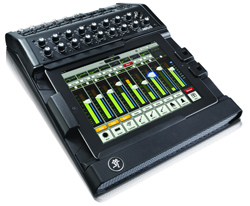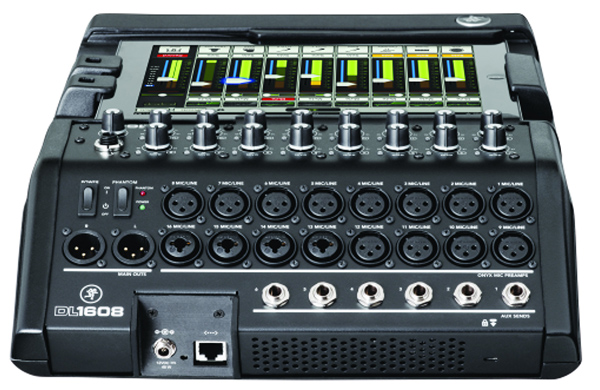Editor’s Note: Author Ben Olswang is a product manager with Mackie.
Remember when mixers had faders and knobs? We at Mackie certainly hope this is what future audio engineers will be saying.
At least, that is one of the major concept-shifting ideas behind the new Mackie DL1608 16-channel digital live mixer with iPad control.
But that wasn’t necessarily the design goal from the beginning of the project.
In fact, the DL project was actually something that had been nagging at Mackie for years. We wanted to create a digital version of our 1604 design, but with all the features and benefits that modern digital mixers offer.
Despite many different and arguably very cool interpretations of this concept, we couldn’t get the price down to reach our target customers. Simply put, the iPad allowed us to approach the design in an entirely new way.
OUT WITH THE OLD
At the heart of the DL1608 is a hardware-based digital engine doing all of the audio processing and low-latency mixing, but we knew we could get rid of the traditional mixing controls with some clear benefits.
We could do without costly moving faders, imprecise V-Pots and monochrome screens. Implementing high-resolution, full-color screens into a mixer is cost prohibitive. Consumer manufacturers that utilize screens like this have ridiculous buying power that drives their cost down.
Eliminating moving parts also increases reliability, because there is very little that can actually break. And, of course, removing hardware reduces significant cost. The user is no longer paying for faders, encoders, switches or screens. This allowed us to deliver a full-featured, 16-mic-pre digital mixer with a street price of less than $1,000.
However, converting a long-time control paradigm is not without difficulties. When designing the user interface (UI), there were many paths we could have taken.
We could have made it look exactly like our most popular mixer design, or we could have abandoned all logic gained from years of interactive development with customers. Neither of these made sense, so we worked hard to bridge that gap.
Using relatively standard workflow makes audio engineers comfortable. After all, the very nature of a touch interface is new to the vast majority of engineers. But the ease of using an iPad was powerful and could open up the interface to a whole new group of users. The iPad is amazing in that it significantly reduces the intimidation factor for new users.
And, the UI design will continue to be something that can be constantly improved upon, breathing life into the overall product.
DOWN TO SIZE
The iPad-centric design eliminates a lot of bulky hardware. We don’t need room for knobs and faders. Instead the size of the mixer is governed by the size of the mic pres, I/O and the iPad tray. Once we started the design process it became obvious that the footprint could get really small.
From that point, minimizing size became a major project goal. The DL1608 has a front-to-back length of 15.5 inches, 11.5 inches wide and (thanks to a sloped I/O back panel) stands only 3.9 inches high. It weighs just under 8 pounds.
To save additional space, we decided to arrange the mic inputs and mic gain control in two rows of eight, which is fairly unconventional. We had to ensure that the Onyx mic preamps would perform to spec in this new, more tightly packed environment.
Using an external power supply also helped to reduce size. We didn’t want to sacrifice performance here either, so chose a quality supply with a locking connector and universal 100-volt to 240-volt operation. External power supplies have the added benefit of simplified serviceability – they’re easily replaced if something goes wrong. It also minimizes heat within the chassis.
The largest area on the mixer is the iPad tray. While it may seem like a no-brainer, the tray required a lot of thought during the design process. We wanted the DL1608 to seamlessly transition from wired to wireless operation, so the tray had to be highly durable to withstand repetitive insertion and removal of an iPad. Plus, it needed to not only fit the current iPad designs, but also be ready for future variations.

















